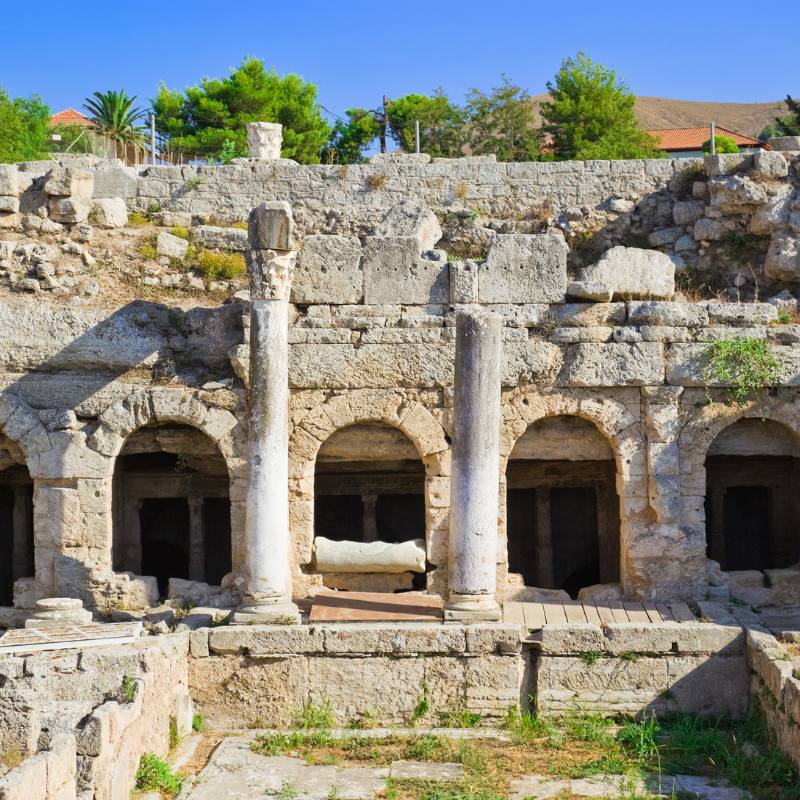Introduction
Ancient Corinth, a fascinating and integral part of Greece’s rich and storied history, stood as one of the largest and most influential cities of its time. Nestled at the picturesque northern base of the hill of Acrocorinth, this vibrant ancient city thrived as a bustling hub of trade, benefiting from its strategic location, abundant natural springs, and the surrounding fertile plains that sustained its flourishing economy.
Not only was Ancient Corinth renowned for its commercial prosperity, but it also held great cultural and historical significance. The city was home to magnificent temples, including the iconic Temple of Apollo, where citizens sought solace and divine guidance. Art and architecture flourished, and the city became a melting pot of different cultures and ideas.
Moreover, Ancient Corinth’s indelible impact on Greek history cannot be overstated. It played a pivotal role in shaping the political landscape of ancient Greece and was a center of intellectual and artistic innovation.
The Corinthian Order, a distinctive architectural style characterized by its elegant and ornate columns, emerged from this vibrant city, leaving an enduring legacy on the architectural world.Exploring the cultural and historical nuances of Ancient Corinth unveils a captivating tapestry of stories, intertwining the lives of ancient Greeks with the city’s vibrant past.
From its bustling markets to its grand temples, Ancient Corinth stands as a testament to the ingenuity and resilience of an ancient civilization, forever etched in the annals of Greek history.
Location and Geographical Significance
Corinth, a captivating ancient city, is located eighty kilometers west of Athens. Its strategic location on the picturesque south side of the Isthmus makes it a vital connecting link between the Peloponnese and mainland Greece, thus amplifying Corinth’s significance as a bustling hub for commerce and naval power.
This unique geographical position has not only shaped Corinth’s history but also contributed to its active participation in numerous Greek wars, playing a pivotal role in shaping the region’s rich tapestry of events and exerting a profound influence that echoes through the ages.
The Early Days: Neolithic Period
The site of Ancient Corinth has a rich history that dates back to the Neolithic period, which spanned from 6500 to 3250 B.C. During this time, the area was inhabited, laying the foundation for the future development of a major city. The Neolithic period in Ancient Corinth was characterized by the emergence of agriculture and the transition from a nomadic lifestyle to settled communities.
People began cultivating crops and domesticating animals, leading to a more stable and structured society.In addition to the advancements in agriculture, the Neolithic inhabitants of Ancient Corinth also demonstrated remarkable artistic and architectural innovations. They developed their own unique style of pottery, which is known as black-figure pottery.
This technique involved painting black figures on a clay surface and then firing it in a kiln. The invention of black-figure pottery marked a significant artistic achievement and became a distinctive feature of Ancient Corinth’s cultural identity.
The Neolithic period of Ancient Corinth laid the groundwork for the future growth and development of the city. It set the stage for the architectural and artistic advancements that would come to define Ancient Corinth in the centuries to come.
The legacy of this period can still be seen in the remnants of ancient structures and the artistic treasures that have been unearthed, providing valuable insights into the early history of this remarkable city.

The Rise and Fall of Ancient Corinth
Corinth, an ancient city in Greece, experienced a remarkable rise and fall throughout its history. By 400 BC, its population had reached an impressive 90,000, positioning it as one of the largest cities in Greece at the time. This growth was fueled by its strategic location, advantageous trade routes, and a thriving economy.
However, Corinth’s prosperity was not without its challenges. The city found itself embroiled in conflicts, both internal and external. Political rivalries, power struggles, and territorial disputes were common occurrences in Corinth. These tumultuous times tested the resilience of the city and its inhabitants.
Tragically, in 146 BC, the Romans razed Corinth to the ground, marking a significant turning point in its history. The destruction of the city stands as a testament to the turbulent times it endured and the power struggles that ultimately led to its downfall.
Despite its fall, Corinth’s legacy lives on. The ruins of ancient Corinth serve as a reminder of its once-great stature and the rich history that unfolded within its walls. The rise and fall of Corinth offer valuable insights into the complexities and uncertainties of ancient civilizations, leaving us with a profound understanding of the ebb and flow of human history.
A Hub of Art and Architecture
Despite the numerous trials and tribulations it faced, Corinth persevered as a shining beacon of culture and innovation throughout history. This ancient Greek city boasts a rich heritage and is renowned for its contributions to mythology, being the legendary birthplace of Jason and the Argonauts.
Today, the ruins of Corinth serve as a captivating testament to its former glory, captivating visitors with its architectural marvels and awe-inspiring landmarks. Among these remarkable structures are the majestic Temple of Apollo, a sacred site that once housed extravagant rituals, and the enchanting Fountain of Peirene, a source of water that symbolized prosperity and beauty.
Exploring the remnants of Corinth’s past is an extraordinary journey that immerses one in the grandeur and legacy of this extraordinary city.
Conclusion
The story of Ancient Corinth is a tale of growth, conflict, and resilience. Its influence on Greek history is undeniable, from its role in trade and warfare to its contributions to art and architecture. The city’s ruins, scattered within the modern village, continue to attract scholars and tourists alike, eager to explore Corinth’s rich past.

